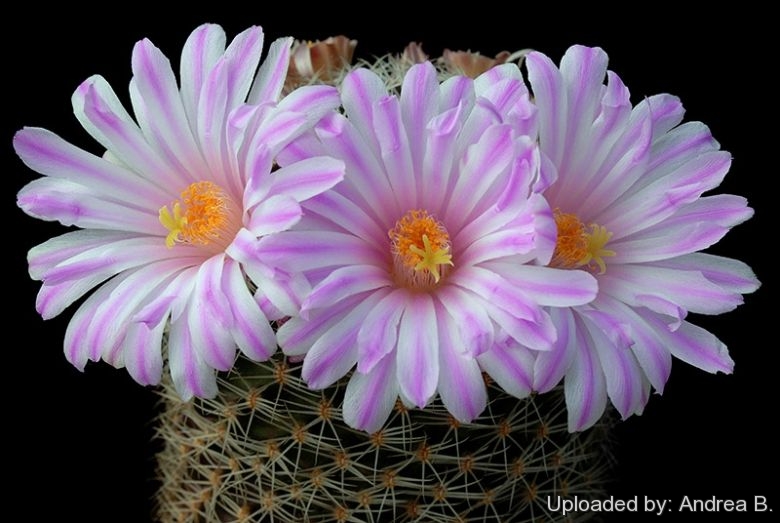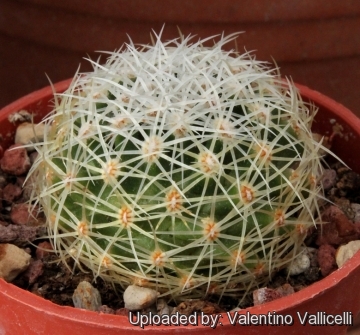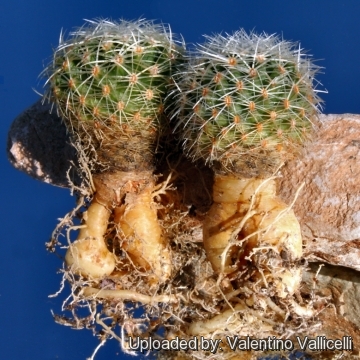




Your support is critical to our success.

Origin and Habitat: Puebla, Southern-western Mexico.
Type locality: Mountains west of Tehuacan, Mexico.
Altitude: 1700 - 2350 metres above sea level.
Synonyms:
- Mammillaria napina J.A.Purpus
- Bartschella napina (J.A.Purpus) Doweld
- Neomammillaria napina (J.A.Purpus) Britton & Rose
Description: Habit: It is a small perennial geophyte cactus usually solitary, rarely clustering and barely rising above ground level. Flowers are quite large for a Mammillaria, pale carmine to pink with near white throats.
Roots: Tap root, thick, but when in a cluster of 3 or 4 somewhat spindle-shaped.
Stems: Semiglobose to globose, 4-6 high and in diameter.
Tubercle: Conical low, terete in section, not at all milky. Parastichy number 8 - 13.
Axil: Somewhat woolly or naked.
Radial spine: 10-12, pectinate, slightly curved, glassy white with yellow bases, 8-10 mm long, spreading and interlacing.
Central spine: Usually absent, rarely one.
Flower: Bell shaped, up to 40 mm long and in diameter pale carmine or pink, with distinctive whitish throats,. Petals pale pink with deeper mid-stripe.
Fruit: Ripening almost embedded in the plant body, colourless.
Blooming season: Summer.
Seed: Black.
Remarks: The dense covering of spines reduces the interception of solar radiation by the stem surface lowering the risks of overheating the apex during a summer day and of freezing during a winter night.
Bibliography: 1) Robert T. Craig “The Mammillaria handbook: with descriptions, illustrations, and key to the species of the genus Mammillaria of the Cactaceae” E P Publishing, 1945
2) John Pilbeam “Mammillaria The Cactus File Handbook” page 204. Cirio Pub. Services, 01/Dec/1999
3) Arthur Gibson, Park Nobel “The cactus primer” Harvard University Press, 01/Oct/1990
4) Edward Anderson “The Cactus family” Timber Press, Incorporated, 2001
5) James Cullen, Sabina G. Knees, H. Suzanne Cubey "The European Garden Flora Flowering Plants: A Manual for the Identification of Plants Cultivated in Europe, Both Out-of-Doors and Under Glass" Cambridge University Press, 11/Aug/2011
6) David R Hunt; Nigel P Taylor; Graham Charles; International Cactaceae Systematics Group. "The New Cactus Lexicon" dh books, 2006
7) N. L. Britton, J. N. Rose “The Cactaceae. Descriptions and Illustrations of Plants of the Cactus Family.” Volume 4, The Carnegie Institution of Washington, Washington 1923,
8) Curt Backeberg: “Die Cactaceae: Handbuch der Kakteenkunde” Volume V, Gustav Fischer Verlag, Stuttgart New York 1982–1985,
9) Ulises Guzmán, Salvador Arias, Patricia Dávila: “Catálogo de cactáceas mexicanas.” Universidad Nacional Autónoma de México, Mexiko-Stadt 2003, ISBN 970-9000-20-9,

Mammillaria napina Photo by: Valentino Vallicelli

Mammillaria napina Photo by: Valentino Vallicelli
Cultivation and Propagation: Is one of the dwarf tuberose Mammillaria with large flowers, somewhat difficult to cultivate. During the summer it is best to keep the plants outside where the temperature can rise to over 30° C with no harm to the plant, recommended for any collection that needs lots of light with ample airflow.
Growth rate: It is a small growing, but easily flowering species.
Soils: Use a an open and free draining mineral compost with little organic matter (peat, humus) that allows therefore roots to breath (as it is rot prone).
Repotting: Repotting every 2-3 years. A pot a little larger than average for the size of the plant should be used, filled with very porous compost. Use a deep pot with good drainage.
Watering: It likes a winter's rest and should be kept almost completely dry during the winter months, If the soil is allowed to be dry for too long root loss could follow but equally the same result would occur if the plants are both wet and cold. From March onwards the plant will begin to grow and watering should be increased gradually until late May when the plant should be in full growth. Water regularly during the summer so long as the plant pot is allowed to drain and not sit in a tray of water. During hot weather you may need to water the plants more frequently so long as the plant is actively growing. From late September watering should be reduced to force the plant to go in to a state of semi dormancy, by October you should be back in to the winter watering regime. Keep dry with ample airflow in winter. In the rest period no high atmospheric humidity!! Care must be taken with watering as they tends to become swollen and untidy in growth habit if given too much water and shade.
Fertilization: Feeding may not be necessary at all if the compost is fresh then, feed in summer only if the plant hasn't been repotted recently. Do not feed the plants from September onwards as this can cause lush growth which can be fatal during the darker cold months.
Hardiness: Grown specimens resist to -4°C for a short time, but it is best to keep above 5° C to avoid ugly spots on the plant epidermis. Some warmth throughout the year will increase the grower's success.
Exposition: Need full sun avoiding only the harshest summer sun, if kept too dark they may become overly lush and greener and could be prone to rotting due to over watering. Tends to bronze in strong light, which encourages flowering and heavy wool and spine production.
Uses: It is an excellent plant for container growing. It always looks good and stays small. It look fine in a cold greenhouse and frame.
Pests & diseases: It may be attractive to a variety of insects, but plants in good condition should be nearly pest-free, particularly if they are grown in a mineral potting-mix, with good exposure and ventilation. Nonetheless, there are several pests to watch for:
- Red spiders: Sensitive to red spider mite. Overhead watering is helpful in controlling mites.
- Mealy bugs: Occasionally mealy bugs they develop aerial into the new growth among the wool with disfiguring results, but the worst types develop underground on the roots and are invisible except by their effects.
- Scales: Scales are rarely a problem.
- Rot: Rot it is only a minor problem with cacti if the plants are watered and “aired” correctly. If they are not, fungicides won't help all that much.
Propagation: Direct sow after last frost. (seldom produces offsets). Seeds germinate in 7-14 days at 21-27° C in spring, remove the glass cover gradually as the plants develops and keep ventilated, no full sun for young plants! The seedlings should not be disturbed until they are well rooted, after which they can be planted separately in small pots.
| Your Actions | |
|---|---|
| Back to Mammillaria index | |
| Back to Cactaceae index | |
 |
Back to Cacti Encyclopedia index |
Privacy stantement - Terms and conditions - How to cite - About us - Feedback - Donate




